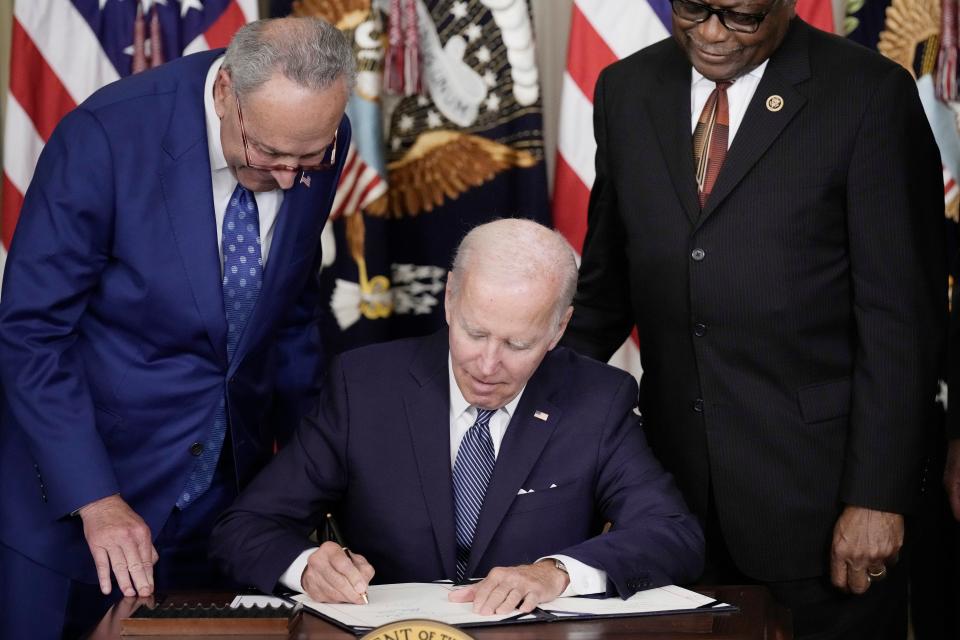Biden's State of the Union address confirms America's in a clean energy boom
When President Joe Biden worked with Congress to deliver ambitious clean energy incentives last August, he pledged they'd help confront the climate crisis, create jobs, strengthen our communities and make the country more energy secure.
As he affirmed in his State of the Union address Tuesday, it’s working.
In the first three months after the incentives were enacted, corporations announced more than $40 billion in clean energy investment. These are projects to get clean power from the wind and sun and to build or expand factories across the USA to make solar panels, wind turbines, advanced batteries and electric cars. An additional $11.4 billion in such projects was announced in January, bringing the total to more than $51 billion.
Clean energy contributes to record low unemployment
The clean energy boom is driving a genuine economic renaissance sweeping through states such as Georgia, Kansas, Michigan, Ohio, South Carolina and more. It’s creating tens of thousands of jobs and strengthening the domestic supply chain for technology that’s critical to the clean energy economy.
'Dark Brandon' shows up at SOTU: Biden mops the floor with lost Republicans
The Latino State of the Union: Biden has done a lot for us, but fails on immigration
These incentives, in other words, are doing exactly what the president said they would – one reason why unemployment has fallen to its lowest level since the Beatles were together.
What’s important in the coming year is that we build on these gains. This will take continued progress on three important fronts:
►The $370 billion in strategic clean energy investment contained in last year’s Inflation Reduction Act must be implemented in an effective and timely way. This starts with Congress. It must make sure that key federal agencies – the Departments of Energy, Transportation, Treasury, and the Environmental Protection Agency and others – have the staff and resources they need to administer this funding as intended.
A key to successful implementation is a commitment to the principles embodied in the Justice40 Initiative, pledging to direct at least 40% of the environmental, health, social and economic benefits of climate resilience and clean energy investments toward low-income communities and people of color.
State and local officials have a role to play in seeing to it that these investments are deployed for the intended purpose and to the intended effect, and all of us must help make sure our leaders, at every level, do exactly that.

►The Biden administration must use its authority under existing law to complement this investment by developing robust rules and standards to help clean up our cars, trucks and dirty power plants, which together account for roughly half the nation’s carbon footprint; help to make our homes and workplaces more efficient; cut leaks of methane, a powerful greenhouse gas, from oil and gas operations; and keep investors apprised of corporate climate risk.
Institute for Climate and Peace: Could we save Earth if we treated it like a child?
U.N. secretary-general: 5 steps to help us kick our fossil fuel addiction
These standards and safeguards were always meant to go hand in glove with the clean energy incentives in the Inflation Reduction Act. The incentives make it easier and cheaper for power companies and industry to meet the climate objectives these standards advance. That’s important. The clean energy incentives have positioned the country to cut carbon pollution and other greenhouse gases about 40% below 2005 levels by 2030.

Biden has pledged to reduce that pollution 50-52% by then, as the science says we must to avert climate catastrophe. With strong rules and standards, we can get there. It’s time for the administration to shift into high gear and produce the standards we need to get the job done.
Getting developers, Indigenous tribes, communities, government officials together early on
►Finally, we must strengthen and improve the federal approval process, so that wind and solar power, and the transmission and storage grid they require, can be responsibly built on the scale and timeline that confronting the climate crisis demands.
That begins with a proven approach some call “Smart from the Start.”
It means identifying sites early on that are appropriate for clean energy and transmission projects, encouraging growth in those areas, and making clear decisions about areas that are off the table for development to help guide the renewable energy build-out.
Semiconductor manufacturing is the new oil: America just won a major victory over China. And it happened in Arizona.
Opinions in your inbox: Get exclusive access to our columnists and the best of our columns throughout the week
It means using sound science and authoritative data to assess the costs and benefits of a project upfront.
And it means getting developers, Indigenous tribes, communities, government officials and others together early on with those most directly impacted by proposed projects, so that questions can be answered, concerns addressed and potential conflicts resolved as soon in the process as possible.
Opinion alerts: Get columns from your favorite columnists + expert analysis on top issues, delivered straight to your device through the USA TODAY app. Don't have the app? Download it for free from your app store.
One thing more: States now often hold a veto, in effect, over the expansion and modernization of electricity transmission lines, transformers and related gear needed to connect new wind and solar power to the grid. A clean, reliable and resilient power grid is essential to the functioning of a modern economy. That’s the kind of national interest we look to federal authority to ensure.
The country is making enormous progress.
"The Inflation Reduction Act is ... the most significant investment ever to tackle the climate crisis," Biden said Tuesday night. "Lowering utility bills, creating American jobs, and leading the world to a clean energy future."

To build on those gains, we must implement the clean energy incentives enacted last year in a timely, effective way. The administration must develop standards and rules to help us get the most from those incentives. And we must strengthen and improve the permitting process.
That’s the way to drive forward the clean energy renaissance that’s creating jobs, strengthening our communities and making the country more energy secure.
Manish Bapna is president of the Natural Resources Defense Council, an environmental advocacy group with more than 3 million supporters nationwide.
You can read diverse opinions from our Board of Contributors and other writers on the Opinion front page, on Twitter @usatodayopinion and in our daily Opinion newsletter. To respond to a column, submit a comment to letters@usatoday.com.
This article originally appeared on USA TODAY: State of the Union confirms clean energy incentives are working for US

 Yahoo Movies
Yahoo Movies 
